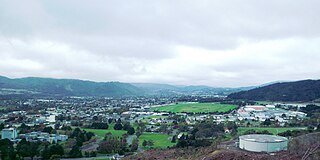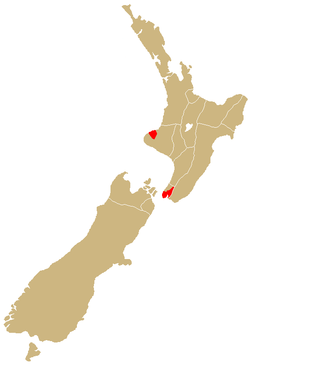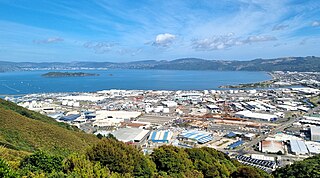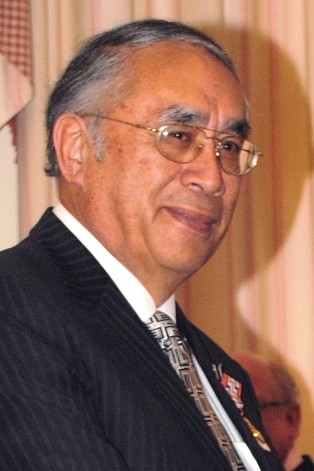 The ground in 2024 | |||
| Ground information | |||
|---|---|---|---|
| Location | Lower Hutt, New Zealand | ||
| Establishment | 1967 (first recorded match) | ||
| Team information | |||
| |||
| As of 1 January 2024 Source: Ground profile | |||
Te Whiti Park is a cricket ground in Lower Hutt, Wellington, New Zealand.
 The ground in 2024 | |||
| Ground information | |||
|---|---|---|---|
| Location | Lower Hutt, New Zealand | ||
| Establishment | 1967 (first recorded match) | ||
| Team information | |||
| |||
| As of 1 January 2024 Source: Ground profile | |||
Te Whiti Park is a cricket ground in Lower Hutt, Wellington, New Zealand.
The park is named after the Māori spiritual leader Te Whiti o Rongomai, whose family lived in the area. [1] The land in the areas belonged to Te Āti Awa who used the park to graze animals. In 1943 the Government took control of the land and it was used as a military vehicle park in World War II. Te Āti Awa accepted a £47,000 compensation payment for the land seizure, though much of it went to the Lower Hutt City Council for outstanding rates bills. After the war it was then leased to the council and used as a sports field until 1979 when it transferred to council ownership from the Crown. [2]
The first recorded cricket match held on the ground came in 1967 for domestic women's first-class cricket. [3] In 1978 the park hosted a one-day World Series Cricket match during the tour of New Zealand between the World XI and Australia. Australia won the game by 7 runs. [4]
A riser overlooking the park was constructed by the council and opened in 2015. [5]

The Hutt Valley is the large area of fairly flat land in the Hutt River valley in the Wellington region of New Zealand. Like the river that flows through it, it takes its name from Sir William Hutt, a director of the New Zealand Company in early colonial New Zealand.

Upper Hutt is a city in the Wellington Region of New Zealand and one of the four cities that constitute the Wellington metropolitan area.

The Hutt Valley campaign was an armed conflict in the lower North Island of New Zealand between indigenous Māori and British settlers and military forces in 1846. The campaign was among the earliest of the 19th century New Zealand Wars that were fought over issues of land and sovereignty. It was preceded by the Wairau affray and followed by the Wanganui campaign and was triggered by much the same pressures—the careless land purchasing practices of the New Zealand Company, armed government support for settler land claims, and complex intertribal tensions between local Māori. The three conflicts also shared many of the same combatants.

The Hutt River flows through the southern North Island of New Zealand. It flows south-west from the southern Tararua Range for 56 kilometres (35 mi), forming a number of fertile floodplains, including Kaitoke, central Upper Hutt and Lower Hutt.

Petone is a large suburb of Lower Hutt, Wellington. It stands at the southern end of the Hutt Valley, on the northern shore of Wellington Harbour.
Te Whiti o Rongomai III was a Māori spiritual leader and founder of the village of Parihaka, in New Zealand's Taranaki region.

Alicetown is a central suburb of Lower Hutt located at the bottom of the North Island of New Zealand.
Tohu Kākahi was a Māori leader, a warrior leader in the anti government Hau Hau Movement 1864-66 and later a prophet at Parihaka, who along with Te Whiti o Rongomai organised passive resistance against the occupation of Taranaki in the 1870s in New Zealand.
Wellington Regional Council, branded as Greater Wellington Regional Council, is the regional council overseeing the Wellington Region of New Zealand's lower North Island. It is responsible for public transport under the brand Metlink, environmental and flood protection, and the region's water supply. As of 2023, it is the majority owner of CentrePort Wellington with a 77% shareholding.

Te Āti Awa is a Māori iwi with traditional bases in the Taranaki and Wellington regions of New Zealand. Approximately 17,000 people registered their affiliation to Te Āti Awa in 2001, with around 10,000 in Taranaki, 2,000 in Wellington and around 5,000 of unspecified regional location.

Lower Hutt is a city in the Wellington Region of New Zealand. Administered by the Hutt City Council, it is one of the four cities that constitute the Wellington metropolitan area.

Waiwhetū is an eastern suburb of Lower Hutt in the Wellington Region situated in the south of the North Island of New Zealand.

Kaitoke Regional Park is regional park located at Kaitoke, northeast of Upper Hutt, in the Wellington Region of New Zealand's southern North Island. It is administered by Wellington Regional Council, alongside the adjacent Hutt Water Collection Area.

Seaview is an industrial suburb of the city of Lower Hutt, in Wellington, New Zealand. Situated on the eastern coast of the Hutt Valley, the suburb lies between Te Awa Kairangi / the Hutt River and Petone, and the bays of Eastbourne to the south. Seaview is a centre for bulk liquid fuel storage for the lower half of the North Island, and a site for heavy industry. It is also a base for support services for trucks and transportation businesses and the location of the wastewater treatment plant for drainage from the Hutt Valley. Seaview is home to the Port Road Drags, the longest-running street drag races in Australasia.

The Wellington Blaze is the women's representative cricket team for the New Zealand city of Wellington. They play their home games at Basin Reserve. They compete in the Hallyburton Johnstone Shield one-day competition and the Women's Super Smash Twenty20 competition. They are the most successful side in the history of the Super Smash, with eight title wins.
Ihakara Porutu "Kara" Puketapu was a New Zealand public servant and Māori leader. He served as Secretary of Maori Affairs and was later chair of Te Āti Awa based in Waiwhetū, Lower Hutt.

The Hutt Recreation Ground is a football, cricket and rugby union ground in Lower Hutt, Wellington, New Zealand. The grounds are owned by the Hutt City Council and managed for them by Downer.

Īhāia Pōrutu Puketapu was a New Zealand tribal leader, butcher, roading contractor and labourer. Of Māori descent, he identified with the Te Āti Awa iwi. He was born in Waiwhetū, New Zealand, on 7 February 1887.

Darcy John Nicholas is a New Zealand artist, writer and art administrator.

Petone Settlers Museum is a local history museum located in the Wellington Provincial Centennial Memorial, a historic building in Petone, Lower Hutt, New Zealand. The building was originally constructed to mark the Wellington province's centennial commemorations; the museum opened in the building in 1977. The building was extensively refurbished in 2016.